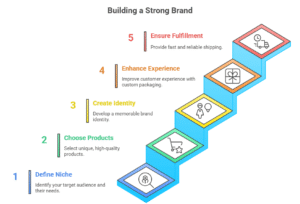In 2025, dropshipping remains a viable business model, but the landscape has evolved. Generic stores with commonplace products no longer suffice. To succeed, entrepreneurs must focus on strategic branding dropshipping to differentiate themselves in a crowded marketplace.

Why Many Dropshippers Fail to Differentiate
-
Lack of Branding: Utilizing standard themes and generic logos fails to create a memorable impression.
-
Generic Product Selection: Offering the same products as countless other stores provides no unique value proposition.
-
Subpar Customer Experience: Issues like delayed shipping, inadequate tracking, and poor communication erode customer trust.
Step-by-Step Guide to Building a Distinctive Dropshipping Brand
1. Identify Your Niche and Target Audience
Define a specific niche and understand your ideal customer profile. For instance, targeting eco-conscious millennials interested in sustainable home goods allows for tailored branding and marketing strategies.
2. Select Unique, High-Quality Products
Utilize platforms like NicheBay to source distinctive, high-quality products that align with your brand values. Offering exclusive items enhances perceived value and fosters customer loyalty.
3. Develop a Cohesive Brand Identity
Create a compelling brand name, design a distinctive logo, and establish a consistent brand voice. Ensure that all visual and textual elements resonate with your target audience and reflect your brand’s core values.

Enhancing Customer Experience
Custom Packaging and Quality Assurance
Invest in custom packaging to create a memorable unboxing experience. Implement quality control measures to ensure product consistency and customer satisfaction.
Efficient Shipping and Transparent Communication
Partner with reliable suppliers to ensure prompt order fulfillment. Maintain transparent communication with customers regarding order status and shipping timelines.
Marketing Your Brand Effectively
Storytelling and Email Marketing
Share your brand’s story to build an emotional connection with customers. Utilize email marketing to provide value, share updates, and foster a sense of community.
Leveraging Influencer Partnerships and User-Generated Content
Collaborate with micro-influencers and encourage customers to share their experiences. Authentic content from real users enhances credibility and expands brand reach.
Case Study: Transforming a Generic Store into a Recognizable Brand
Consider the example of “GlowNest,” a store that initially offered generic products. By rebranding, selecting niche-specific skincare products, implementing custom packaging, and sharing their brand story through email campaigns, they tripled their sales within six months. This transformation underscores the power of strategic branding in achieving dropshipping success.
1. Understand Your Target Audience
Begin by identifying your ideal customer profile. Consider demographics, interests, and pain points. This understanding enables you to tailor content that resonates and addresses specific needs.
2. Set Clear Goals and Objectives
Define what you aim to achieve with your content marketing efforts. Common objectives include increasing website traffic, generating leads, and building brand awareness. Establishing clear goals helps in measuring success and guiding content creation.
3. Choose the Right Content Types
Select content formats that align with your audience’s preferences and your brand’s message. Options include blog posts, videos, infographics, and social media updates. Diversifying content types can enhance engagement and reach.
4. Create a Content Calendar
Develop a content calendar to plan and organize your publishing schedule. This ensures consistent content delivery and allows you to align content with key dates and product launches.
5. Optimize for SEO
Incorporate relevant keywords into your content to improve search engine visibility. Focus on both on-page SEO elements, such as meta descriptions and headers, and off-page strategies like backlink building.
6. Leverage User-Generated Content
Encourage customers to share their experiences with your products. User-generated content, such as reviews and social media posts, can build trust and provide authentic insights into your brand.
7. Monitor and Analyze Performance
Regularly assess the performance of your content through metrics like engagement rates, conversion rates, and traffic sources. Use these insights to refine your content strategy and improve future outcomes.
Conclusion: Prioritize Branding for Sustainable Success
In a saturated dropshipping market, building a distinctive brand is essential for long-term success. By focusing on niche selection, product quality, cohesive branding, and exceptional customer experience, you can differentiate your store and foster customer loyalty.
Ready to elevate your dropshipping business? Explore platforms like NicheBay to access tools and resources that support brand development and operational efficiency.
